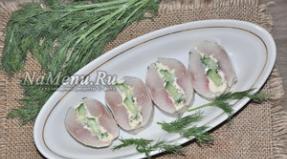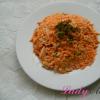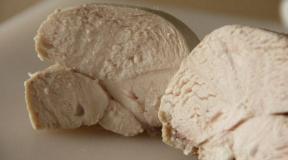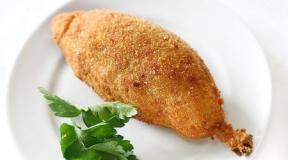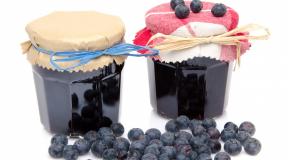The most unusual and strangest food in the world. The worst food in the world
We present a selection of food that not every daredevil can try.
Fugu - Japan

Most of us do not seriously consider the possibility of getting poisoned and dying right during dinner, but for those who dare to eat fugu, such a possibility is quite real. Fugu is a Japanese fish that contains enough poison to kill 30 people at once. The chefs who prepare this costly Japanese delicacy must first go through years of training. Whether this fish is grilled, stewed or served as the finest sashimi, any slightest mistake in the cooking process is automatically fatal to the person who eats the finished dish. If you're willing to take a chance on a deadly delicacy, head to Japan from October to March, during fugu season.
Fried Spiders - Cambodia

You can try this exotic dish anywhere in Cambodia, but the town of Skuon specializes in fried spiders: here creepy creatures are fried in oil with garlic so that they become crispy on the outside and soft, sticky inside. The tradition of roasting spiders and eating them probably began during the era of the brutal Khmer Rouge regime, when villagers had to look for alternative sources of food. Spiders are often sold to tourists who walk around the city and want to eat on the go. Fried spiders are not only the richest source of protein, but also, according to rumors, a miracle remedy for improving appearance.
Roasted ox testicles - Canada

The original name of this dish, Prairie Oysters, can literally be translated as "prairie oysters", but there are no oysters at all - this exotic dish is made from bull testicles. You can try fried bull eggs anywhere in Canada, but for curious gourmets, Alberta is the best place to go. Buzzards in Calgary serves this dish throughout the summer months and celebrates it with an annual "Egg Festival". The dish is prepared in different ways - bovine testicles are deep-fried, stuffed, stewed with herbs and spices.
Balut - Philippines

A variety of egg dishes are prepared all over the world, but in the Philippines there is a special culinary tradition: duck eggs are boiled here with an already formed embryo (that is, in fact, the embryo is boiled alive in the shell). It is customary to eat the dish seasoned with vinegar, garlic and chili in its entirety - the entire contents of the egg are eaten, including the already formed wings and beak. Balut is often sold on the streets along with cold beer.
Haggis - Scotland

This national Scottish dish is a mixture of sheep's heart, liver and lungs, onions, spices and oatmeal. The sheep stomach is stuffed with all these ingredients, and then it is stewed. The history of haggis goes back to the 15th century, and today the dish is considered the basis of the festive menu for the national Scottish holiday - the birthday of Robert Burns (celebrated on January 25). Haggis is served with mashed potatoes and turnips. And in order to swallow haggis, inexperienced tourists are also poured a drop of Scotch whiskey for courage. By the way, haggis is the richest source of iron and fiber, and if you wish, you can buy it ready-made in almost any grocery store.
Sannakji - South Korea

An original delicacy from South Korea, sannakji is a real live octopus that is eaten either whole or cut into pieces depending on the size. The octopus is served raw, seasoned with a dash of sesame oil - and still alive, so you can see how its tentacles tremble. Sannakji is not only an extremely exotic dish, but also life-threatening: octopus suckers can stick to the throat from the inside, causing suffocation or even death. Although the taste of the octopus is nothing special, trying to eat an octopus alive while it grabs the face of a particularly daring gourmet with its tentacles is indeed a memorable experience, to say the least.
Escamoles - Mexico

Escamoles looks like a salad of some kind of cereals, but in fact this dish is made from ant eggs. This dish is often called "ant caviar" and is considered an exquisite delicacy in Mexico, and the history of the recipe dates back to the Aztec era. Ant eggs are harvested from the roots of agave trees and added to tacos or omelettes, or cooked as a meal on their own. Despite the rather unpleasant composition of the ingredients, escamoles has a surprisingly pleasant taste - ant eggs fried or seasoned with oil have an original nutty flavor.
Hakarl - Iceland

Eating rotten shark meat is not the most tempting prospect, but fresh Greenland shark meat is poisonous. Therefore, for a start, shark meat is allowed to ferment and rot, after which it becomes edible - if, of course, someone manages to try hakarl, not paying attention to the fetid smell of rot and the disgusting fishy taste. Those who risk trying hakarl for the first time most often start to feel sick, so it is recommended to precede the meal with a couple of servings of local alcohol. But the usual inhabitants of Iceland eat hakarl all year round, and rotten shark meat is sold (of course, in vacuum packaging that does not let the "aroma" through) in ordinary supermarkets.
Fried Brain Sandwich - USA

Hamburgers, french fries and fried brain sandwiches? In some US states, and, in particular, in the towns in the Ohio River Valley, this curious dish can still be found on the menu of local eateries. Fried brain sandwiches are made from not-so-terrible ingredients - veal or pork brains, which are carefully fried in batter. And this unusual dish was brought to the United States by emigrants from Germany and Holland, who, apparently, did not like it when something was wasted. Fried brain sandwiches are a very high-calorie dish served with mustard and pickled onions. In fact, the sandwich owes its specific taste to batter, but pork or calf brains are distinguished by a soft, almost indistinguishable aftertaste and a consistency similar to cottage cheese.
Gastronomic tourism is a trendy and growing trend. And even if you are not going to a new country to spend all your time in restaurants, getting to know any national cuisine is an integral part of immersing yourself in a foreign culture.
Today in the Top 10 are the most unusual national dishes of different countries. Sometimes, to taste such a delicacy, special courage is required. But the memories of such an acquaintance with the local cuisine will surely remain for a long time.
 What is this popular Asian fruit compared to. Its smell, according to various reviews, resembles a decaying corpse, athlete's socks, a public toilet. Not without reason in Singapore it is forbidden to carry durian in public transport. But true gourmets claim that the fruit has nothing to do with corpses and rotten meat. Truly developed taste buds allow you to experience a mixture of vanilla pudding and onions.
What is this popular Asian fruit compared to. Its smell, according to various reviews, resembles a decaying corpse, athlete's socks, a public toilet. Not without reason in Singapore it is forbidden to carry durian in public transport. But true gourmets claim that the fruit has nothing to do with corpses and rotten meat. Truly developed taste buds allow you to experience a mixture of vanilla pudding and onions.
9. Guinea pig (Peru)
 These cute little animals are served with pleasure for dinner in the South American Andes. Pigs are baked, fried, grilled. Here they call guinea pigs “kui”, and their meat tastes like chicken.
These cute little animals are served with pleasure for dinner in the South American Andes. Pigs are baked, fried, grilled. Here they call guinea pigs “kui”, and their meat tastes like chicken.
8. Tree borer larvae (Australia)
 Yellowish larvae, oozing with a sticky secret, have long been held in high esteem by local natives. Although they cause nausea in immigrants from Europe, so you won’t be able to taste the delicacy in Sydney and Melbourne. But they can be found during a trip deep into the continent.
Yellowish larvae, oozing with a sticky secret, have long been held in high esteem by local natives. Although they cause nausea in immigrants from Europe, so you won’t be able to taste the delicacy in Sydney and Melbourne. But they can be found during a trip deep into the continent.
7. Virgin eggs (China)
 In the west of Zhejiang province, they came up with the strangest way to cook eggs - they are soaked and then boiled in the urine of boys who are not yet 10 years old. Locals claim that the dish has a positive effect on the circulatory system.
In the west of Zhejiang province, they came up with the strangest way to cook eggs - they are soaked and then boiled in the urine of boys who are not yet 10 years old. Locals claim that the dish has a positive effect on the circulatory system.
6. Lutefisk (Norway)
 A rather strange method of preparation involves soaking dried fish in an alkaline solution of caustic soda. After three days in such an aggressive environment, the fillet is soaked in water. As a result, the meat acquires a jelly-like texture and a pungent smell. Use lutefisk after heat treatment - roasting, baking or boiling.
A rather strange method of preparation involves soaking dried fish in an alkaline solution of caustic soda. After three days in such an aggressive environment, the fillet is soaked in water. As a result, the meat acquires a jelly-like texture and a pungent smell. Use lutefisk after heat treatment - roasting, baking or boiling.
5. Casu Marzu (Italy)
 This cheese is almost impossible to find in a regular supermarket due to sanitary and hygienic rules. But in local shops in Sardinia, kasu marza is sold to real gourmets. The main distinguishing feature of cheese is the presence of cheese fly larvae, which are involved in fermentation.
This cheese is almost impossible to find in a regular supermarket due to sanitary and hygienic rules. But in local shops in Sardinia, kasu marza is sold to real gourmets. The main distinguishing feature of cheese is the presence of cheese fly larvae, which are involved in fermentation.
4. Balut (Philippines)
 This delicacy is said to taste better than it looks. Balut is a duck egg with a mature embryo. Eggs are boiled in their shells and served with salt, vinegar and spices.
This delicacy is said to taste better than it looks. Balut is a duck egg with a mature embryo. Eggs are boiled in their shells and served with salt, vinegar and spices.
3. Snake Soup (Hong Kong)
 Spicy and sour soup with tofu, mushrooms and snake meat improves blood flow and warms in the cold. It is served only in traditional restaurants, where snakes are kept right in the main hall in special wooden boxes.
Spicy and sour soup with tofu, mushrooms and snake meat improves blood flow and warms in the cold. It is served only in traditional restaurants, where snakes are kept right in the main hall in special wooden boxes.
2. Chapulines (Mexico)
 Under such an exotic name, grasshoppers familiar to us are hidden. Mexicans fry insects with salt and chili peppers, and then enjoy them as a crispy and savory beer snack.
Under such an exotic name, grasshoppers familiar to us are hidden. Mexicans fry insects with salt and chili peppers, and then enjoy them as a crispy and savory beer snack.
1 Rocky Mountain Oysters (USA)
 Naturally, there is no question of seafood in the mountains. Rocky Mountain oysters here are called the testicles of young bulls, deep-fried. This dish is especially popular with farmers during the spring castration season for bulls. By the way, not only Americans came up with the original name for a dish of bull eggs. The French call a similar delicacy "white kidneys".
Naturally, there is no question of seafood in the mountains. Rocky Mountain oysters here are called the testicles of young bulls, deep-fried. This dish is especially popular with farmers during the spring castration season for bulls. By the way, not only Americans came up with the original name for a dish of bull eggs. The French call a similar delicacy "white kidneys".
Most likely, most people will refuse if they are offered to taste fried cricket in sauce or fried pork blood. Nevertheless, these dishes are very popular in some countries. And to be fair, these aren't the most disgustingly weird foods people cook and eat.
25. Fish "Yin Yang"

Fish "Yin Yang" is a seafood dish in which the fish is served deep-fried, but remains alive after cooking. The dish is especially popular in Taiwan and China, but it has come under fire around the world for being cruel to fish.
24. Moth larvae

One of the most famous foods in the Australian bush is also one of the most elusive. Moth larvae can only be found in central Australia.
23. Tuna eye

Tuna eyeballs are said to taste similar to squid and are considered a delicacy in Japan (where even doctors claim they are extremely healthy). The only problem is how to eat a dish that looks at you.

A favorite dish in the southwestern United States is fried rattlesnake. It is said to taste a bit like frog legs. Experts advise that before cooking, the meat must be boiled so that it separates from the bones. Then you need to dip it in eggs and cover with a mixture of salt, flour and breadcrumbs, then fry.
21. Shirako
Shirako is a Japanese delicacy that will never become popular in the West. It's... milt or cod semen bags. The dish is said to have a buttery and sweet creamy taste.
20. Sannakji

Sannakji is a delicacy that only a few tourists who have visited Korea dare to try. This delicacy consists of wriggling and wiggling pieces of small octopus flavored with sesame oil. Live octopus is cut into small pieces and immediately served on the table so that the muscles still contract when eating. This dish is quite dangerous to eat, as there is a risk of suffocation (contracting muscles can block the air supply).
19. Pig's blood

In Hungary, when a pig is slaughtered, its blood is not simply drained as usual. It is fried with onions and served with warm fresh bread.
18. Mongolian Budog
This strange dish is popular in Mongolia. It is made from a marmot or goat cooked in its own skin, while the stomach is filled with hot stones.
17. Millennium Egg

The name can be misleading, as these eggs are not so old anymore. The so-called "thousand-year egg" in China is made by storing the egg in a mixture of ash, salt, quicklime, rice husks and clay for several weeks or even months. As it is easy to imagine, this "delicacy" simply stinks unimaginably and inside is black and green jelly.
16. Kiviak

Kiwiak is a traditional Eskimo dish eaten by the Inuit in Greenland during the winter. They make it from auk birds (moreover, in feathers), with which they stuff the carcass of a seal or walrus with an open belly. After that, the carcass is buried for 7-18 months in the ground. Birds literally ferment during this time. After the carcass is dug up, the birds are feathered and skinned and eaten raw at birthdays and weddings.
15. Ching lead

Jing lid is one of the most common snacking insects in Thailand. These are 4 cm long crickets, deep-fried and seasoned with Golden Mountain sauce and pepper. Those who have tried this appetizer say that it is very tasty.
14. Fugu

This dish is not at all disgusting, like most of this list. But it is one of the deadliest foods in the world (and yet people continue to eat it). Fugu's intestines, ovaries, and liver contain a poison called tetrodotoxin, which is 1,200 times more deadly than cyanide. The toxin is so strong that its lethal dose is less than the head of a pin, and one fish contains enough poison to kill thirty people.
13. Frog legs

Few overpower themselves and try this French delicacy. Those who have tried it nevertheless claim that the paws resemble chicken in texture, and fish in taste.
12. Fried tarantulas

In many parts of the world, the vast majority of people are either afraid or disgusted by tarantulas. In Cambodia, however, they are a popular dish. They are literally burned on fire and soaked in oil.
11. Escamoles

Escamoles are edible ant larvae that live in the roots of the blue agave (from which mezcal is made in Mexico). It has been a popular dish in the region since Aztec times. But tourists usually just "shy away" from him.
10. Durian

The fruit, which grows in Malaysia and Indonesia, is perhaps the most "controversial" fruit in the world. Some people really like it, others just can't stand it. Those who dislike it describe the durian as "completely rotten, mushy onions". And its smell is compared to a mixture of pig feces, onions and socks after the gym. The smell is so strong that many hotels and public institutions in Southeast Asia ban durian from their premises.
9. Dragon in the flame of passion
This dish may seem impressive and exotic, but the bizarre name masks its true origin. The most unusual dish on the menu at Beijing's Guolizhuang Restaurant, "Dragon in the Flame of Passion," is a fried yak penis served on a large platter.
8. Crocodile

Everyone knows that shoes and wallets are made from crocodile skin, but in some parts of the world, such as Australia and Africa, crocodiles are a popular dish. They are rumored to taste like a cross between chicken and crabs.
7 Cobra Heart

The next dish is definitely not for the faint of heart. Cobra heart is a dish from northern Vietnam that includes blood and a still beating cobra heart (yes, no typo here - still alive and beating heart). The full meal includes a cobra's heart placed in a glass filled with blood and poison.) This is followed by several dishes made from the remnants of the cobra.
6. Casu marzu

Casu marzu (rotten cheese) is a traditional sheep cheese made by locals in Sardinia, Italy. Cheese producers leave it outside for the flies to lay their eggs in. The larvae hatched from the eggs break down the fats of the cheese and lead to its fermentation. Needless to say, cleaning the cheese of white worms before eating it is simply unrealistic, since casu marzu is literally teeming with them.
5. Bushmeat

The term refers to the meat of wild animals that have been caught in developing regions of the world such as West Africa. This truly strange dish is made from a variety of wild animals, including bats, rats and monkeys, whose meat is smoked, cured or salted.
Bondeki are steamed or boiled silkworm pupae, which are then seasoned with spices and eaten as a snack. Oddly enough, this is one of the most popular foods in Korean cuisine.
1. Balut

This popular Filipino snack is a pre-developed duck embryo that is boiled alive in an egg and eaten straight with feathers, cartilage and beak. Balut in many countries of the world is considered "the most disgusting or strange food."
Much nicer to taste, unless, of course, you have a tidy sum.
Different countries and different peoples have their own ideas about food - therefore, the boundaries between edible and non-edible are very, very conditional.
I bring to your attention a series of photographs of the most extreme dishes ... As for me, I would definitely not eat any of the following ...

1. I'll start my post with this cute Peruvian woman throwing a pre-cleaned frog into a blender to make frog juice (extracto de rana), considered in Peru as a powerful aphrodisiac - a means of increasing sexual activity.

2. To my great regret, but in some Asian countries they eat dogs. The photo shows a dog market in South Korea, where the meat of our "smaller friends" is bought up by the owners of cafes and restaurants. Dog meat is a traditional food for many Asian peoples.

3. Rat meat is quite popular in Vietnam. Usually the Vietnamese do not eat gray flea rats from garbage dumps, which, I think, came to your mind now when you hear the word “rat”. They mainly eat field rats that feed on snails and grains.

4. This Peruvian is about to cook a guinea pig dish. These animals are considered a delicacy in Peru, as well as in many other regions of South America.

5. As soon as they do not eat snakes in Asia. Soups are boiled, fried, steamed and even their blood is drunk from them. Their meat is considered very beneficial for health.

6. Cobra eggs and embryos are considered a special delicacy in Taiwan. The Taiwanese are sure that they have healing properties.

7. Bats are eaten on the Indonesian island of Bali. The most common way to cook them is grilled or deep-fried. They are also added to soup or simply stewed with their meat.

8. And this Chinese woman is photographed eating a real penis. Whose he is exactly is not clear, but most likely canine. The fact is that in China, many restaurants offer dishes from the penises of more than 30 different animals. They are considered extremely useful.

9. In Madagascar, restaurants serve lemurs as an “elite dish”. Because of this, some species of these endemic animals are currently on the verge of extinction.

10. And in the province of Zhejiang in eastern China, chicken eggs boiled in the urine of little boys are considered a special delicacy.

11. While at one of the bus stations in Kampong Cham province in Cambodia, you can buy a couple of crunchy spiders seasoned with garlic. They are sold here by numerous street vendors.

12. Many restaurants in the Colombian city of Barichara serve kulonas sauce made from a particularly large variety of ants.

13. And this Saudi handsome man gnaws on the paws of a spiketail. Many in Saudi Arabia believe that the blood of this lizard can heal numerous diseases and strengthen the body.

14. And to continue the topic of frogs: in Vietnam, one of the most popular dishes is - a frog in any form! They are fried and boiled and marinated there.
Well, I will end my “delicious post” with a brave American woman drinking the blood of a cobra while passing survival cursors in the jungle in Thailand. During these courses, US Marines were taught to catch cobras and drink their blood.



